Music Commissions Home | Music Commissions Brief History | Music Commissions Articles List | Composer's Guide to the Piano Accordion
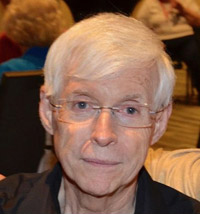
2023 update and expansion of the original version that appeared in the 2016 AAA Festival Journal
Note: the thirty-first commission, Alexander Tcherepnin’s Tzigane, was discussed in the
2014 issue of the AAA Festival Journal.
As may be recalled from the 2015 installment of this series, AAA Composers Commissioning Committee Chair Elsie Bennett was approached in early 1966 by the up and coming young Uruguayan conductor and composer José Serebrier boldly proposing that he be commissioned by the AAA to produce both a solo piece and a concerto-like work for the accordion.* The outcomes were the intermediate performance level Danza Ritual, discussed, as mentioned above, in the 2015 issue of the AAA Festival Journal, and the more advanced Passacaglia and Perpetuum Mobile, for Accordion and Chamber Orchestra, the subject of this article.
In 1970 an upbeat report on the already quickly escalating career of Serebrier appeared in the April issue of the Music Journal. Entitled “Serebrier from Uruguay: Composer to Watch,” it was written by Carole Farley, the subject’s admiring bride and now wife of over fifty years as well as world acclaimed operatic soprano. Among Serebrier’s many achievements she listed in the entry was mention of the world premiere of his “concerto” for accordion and orchestra by the “Colorado Philharmonic,” indicating that it had happened sometime in early July 1969.

This is the only published announcement of a premier this writer has been able to find. Unfortunately, Farley did not provide the exact date, location, conductor, or accordionist in the article. Furthermore, in my contacting both the composer and his wife recently, they, themselves, could not recall the details of the Colorado concert and were only aware of the later New York City premiere in 1981, to be discussed below. What follows may be of some interest to the reader in demonstrating the amount of sleuth work researchers often have to go through to find important information on any given subject.
A brief search on the web revealed that the so-named Colorado Philharmonic Orchestra was a “pick up” or “reading” orchestra in a music camp setting for promising music students from all over the country. It was located in Evergreen, a small city and resort area in the Rocky Mountains, not too far west of Denver. The ensemble grew larger and more prominent over the years and is known today as the National Repertory Orchestra, resettled in Breckenridge, yet further west in the mountains. According to the history given on its website, ** the conductor at the time would have been the founder of the organization, cellist Walter Charles. Certain that more details could be provided by the NRO, I contacted its main office only to be informed that there were no records kept of concerts from its early days. Equally curious and frustrating to this end is that Elsie Bennett, viewed by all who knew her to be highly meticulous, persistent, and tireless in sending out press releases and publishing announcements of and articles about new AAA commissions, apparently never knew of any performances of the Passacaglia and Perpetuum Mobile, since none appear in any of her writings or vast correspondence. An exception, however, would be the already mentioned 1981 performance in New York, which she attended (about which more below).
I suspected that the accordionist for the premier was one of the prominent Denver based classical artists of the time, such as Robert Davine or perhaps one of his prominent former students who studied with him during his years as a professor at the Lamont School of Music of the University of Denver, the most prominent of whom were Bill Popp and Patricia Tregellas. When asked, however, Popp (the only surviving member of the three today) responded that he was not the soloist in question and that he did not know of the concert or who the performer would have been. Further searches by the reference librarians of the Denver Central Library also turned up nothing, so the mystery lingered on until I contacted the Lakewood Public Library near Evergreen.
Lakewood’s research librarian, Briana Francis, looked through the summer 1969 files of the local newspaper, the Canyon Courier, and discovered an announcement of the ensemble’s upcoming concert for August 13 (a month later than the time period Farley gave in the Music Journal) with a list of the selections on the program and information about some of the featured performers. The concert was to take place in the Evergreen High School auditorium, the usual site for the CPO’s programs. Accompanying the article was a photograph of one of the soloists, an accordion-wearing young college student, Albert Schlisserman, described as a New York University undergraduate, member not only of the brass section of the CPO, but also of the Adult Syracuse (New York) Orchestra and the National Orchestra Association, and, most pertinent to this writing, highly advanced accordionist. It was further reported that Albert would be “featured with an accordion solo.” Unfortunately, the title of that solo was not reported nor was there any mention of it being a world premiere. Furthermore, when I recently located and contacted Schlisserman, he himself did not recall the title of the piece he played over such a long gulf of time (to be exact, forty-seven years ago as of 2015!). Serebrier indicates in his score that the second main section of the work, titled “Perpetuum Mobile,” may be played as a solo. Perhaps this segment alone is all that Schlisserman played, thus making it at least a world “semi-premiere.”


| Photo and brief announcement in an August 1969 issue of the Lakewood, Colorado newspaper, Canyon Courier, of Albert Schlisherman and his intended performance of an unnamed accordion solo in an upcoming concert that month of the Colorado Philharmonic Orchestra; and the site of the concert, Evergreen High School, Evergreen, Colorado. |
Be that as it may, August 1969 was a good month for Serebrier in Evergreen, since the same newspaper article indicated that another CPO concert to take place earlier, on August 8, was to feature a local saxophonist playing a solo in Serebrier’s “Partita,” doubtlessly referring to his Second Symphony, which bears that subtitle and includes alto saxophone in its instrumentation.
Happily, it was not difficult to find current information on Schlisserman and to contact him. Today, he is a practicing ophthalmologist in the Buffalo area and trumpeter for the nearby Amherst Symphony Orchestra. His biography on the symphony’s webpage reveals an extensive and distinguished musical career paralleling his over forty-year medical practice. *** His duo-instrumental background is easily explained in that his father was a Juilliard graduate who studied trumpet with the great William Vacchiano and his mother studied accordion with the no less great Pietro Deiro, Sr.
While at NYU, Schlisserman gained the distinction of playing accordion in the Broadway production of Fiddler on the Roof and took up accordion lessons with acclaimed New York accordionist and teacher Joseph Biviano. Following graduation, he soon joined the US Army Strolling Strings in Washington DC (thus being one of present AAA Board members Manny Bobenreith’s and Frank Busso, Jr’s predecessors in their similar roles as accordionists in the US armed services), took science courses at George Washington University, and, upon leaving the Services in 1977, enrolled in medical school at the University of Buffalo. As if to be the perfect coming together of parts in a mysterious puzzle created by the coincidence of the subject of the year this article was originally written (2016), Dr. Schlisserman, given that he resided in the Buffalo area and the AAA Festival would take place there that year, consented to add to the festivities by playing two duets with me by Biviano and Biviano’s close associate and fellow founder of the AAA, Gene Van Hallen, in one of my workshops for the occasion.

| Albert Schlisserman and the US Army Strolling Strings, in the 1970s; and, below, recently. |

As indicated above, the only other live performance for which the writer has found printed evidence since the rather obscure and uncertain debut in Colorado occurred twelve years later, on December 6, 1981, at Christ and St. Stephen’s Church in New York City as part of the second season of concerts by the then fledgling North-South Consonance. Established only a year earlier by conductor/composer Max Lipchitz, the organization was and still is dedicated to performing new music by composers of all the Americas. It quickly became one of the highest regarded performance organizations in the contemporary music community and continues to thrive as such to this day.

| Exterior and interior of Christ and St. Stephens Episcopal Church, in New York, where many concerts take place and Passacaglia and Perpetuum Mobile was officially premièred in 1981 by William Schimmel and the North/South Consonance ensemble, Max Lifchitz, conductor and founder. |

The New York program including the Passacaglia and Perpetuum Mobile certainly lived up to its title, “Music by American and Latin American Composers,” offering a good balance of representation from both hemispheres. The featured accordionist was William Schimmel, who had been a close friend of Lifchitz since 1966 when they first met as students at Juilliard.
In addition to the Serebrier selection, Schimmel played four other AAA commissioned works, all solos, that evening: Henry Cowell’s Iridescent Rondo, Otto Luening’s Rondo, Wallingford Riegger’s Cooper Square, and Carlos Surinach’s Pavana and Rondo. The last two of these employ Latin rhythms, as does, of course, the Serebrier selection, thus displaying a good hemispheric balance on the part of the accordion offerings alone within the larger one of the whole concert (of which there were thirteen works in all). Regarding the Luening piece, Schimmel arranged it for accordion and orchestra for the concert, much to the delight of the composer, who was in attendance along with Mr. and Mrs. Serebrier and Elsie Bennett.

| Attendees at the Christ and St. Stephens Church concert, from left to right: Micki Goodman, dancer and wife of William Schimmel, William Schimmel, Elsie Bennett, composer Otto Luening (friend and former mentor of Bennett at Columbia University), José Serebrier, and Bennett. Elsie Bennett photo album. |
Schimmel fondly recalls rehearsing the Serebrier work first at the composer’s New York west side apartment, with Lifchitz playing the orchestral part on the piano, and then once more with the chamber orchestra at the church shortly before the concert the next day. In the years that followed, Schimmel was to play many works, some of them commissioned, many of them his own, for North/South Consonance. Both he and Lifchitz recall that Serebrier was very happy with both the piece and the performance and assured the accordionist that he would include it in one of his own programs in the future. Serebrier also mentioned to the writer recently that many have told him that the Passacaglia and Perpetuum Mobile is a favorite of theirs among his works.
Possibly because of the Latin leaning of the program and the fact that Lifchitz was born and grew up in Mexico City, Juan Arturo Brennan, New York reporter at the time for the Mexico City based newspaper Uno Más Uno, and also recognized as a noted composer, photographer, cinematographer, and television producer, was drawn to the event and stood as the sole critic in attendance. Though Brennan gave an overall favorable review of the program nine days later and proclaimed the accordion works to be the most interesting of all the selections, he made no mention, curiously, of the Serebrier offering. Lifchitz believes that if he had, the editor may have arbitrarily cut it due to lack of printing space (which happens all too often in the press, unfortunately).
Whether or not other significant performances have taken place since (or before) 1981, the composer/conductor recorded it on the Naxos label in 2003, thirty-four years after its possible partial debut in Colorado and twenty-two years after the New York concert. Yi Yao was the accordionist with the composer conducting the Toulouse National Chamber Orchestra.**** Serebrier wrote in the liner notes of the recording the only account this writer has seen of his experience with the AAA, Bennett, or the commissioning of the piece:
| I received a commission from the American Accordionists’ Association to write a work for accordion and chamber orchestra, the Passacaglia and Perpetuum Mobile . . . (1966). The instrument was entirely foreign to me, but Elsie Bennett, longtime president of the organization, and the brains behind their massive commissioning series, lent me an accordion, which I studied for weeks. It was a great challenge, because the chords provided by the buttons on the left side of the instrument were ready-set, giving the composer very little freedom for tonal imagination and variety. The instrument has since then been improved, and composers today do not have that problem. I gave the commission organization a bonus, a piece for solo accordion [Danza Ritual; see below], which I wrote at the same time. |
It is interesting to note that Serebrier, like several other AAA commissioned composers, expressed his initial dismay of certain limitations of the standard stradella left-hand system of the accordion but was now aware of what he thought was the later development of free bass “improvements” for the instrument. Actually, both prominent free-bass systems, the “quint” and “bassetti” formats, were already around and being played by many of the younger artists in 1966, as a likely majority of those reading this article are aware.

| Accordionist Yi Yao, who recorded Passacaglia and Perpetuum Mobile on the Naxos label with the Toulouse Chamber Orchestra, under the direction of the composer. |
The contract between Serebrier and the AAA is dated March 17, 1966, and does indeed call for both a solo work (which resulted in the Danza Ritual discussed in the 2015 AAA Festival Journal installment of this series) and “a work for Solo Accordion and Orchestra” that “will include treble fingering.” The deadline for both compositions was December 1, at which time the composer would be paid the agreed upon sum of $300. The AAA furthermore claimed the right of first performance and recording for two years after the delivery of the scores, but, as has just been indicated, neither apparently happened within that period. Peer International Corporation published the score in 1974 and still holds the rights. One may purchase the accordion sheet music with the piano arrangement of the orchestral score from Peer for practice and rehearsal purposes or an accordion/piano performance, but the full orchestral score is available by rental only, as is typical of most published large ensemble music.
The composition is a delicate, clearly textured work of lovely melodic lines thinly but beautifully orchestrated for chamber string orchestra with the addition of two horns, trumpet, bass trombone, and a percussion section consisting of suspended cymbal, tam tam, tenor drum, and bass drum for the Passacaglia and strings only for the Perpetuum Mobile movement that follows attacca. The accordion is prominently used throughout the work, but is more thematically blended with the ensemble in the Passacaglia than in the Perpetuum Mobile, where it carries the main theme more as the soloist would in a concerto.
The title of the composition is a generic one. That of the first movement harkens back to the Baroque era and the seventeenth century. The term derives from the Spanish pasar (to walk) and calle (street) and originated in Spain as a strummed interlude between instrumentally accompanied dances or songs. Formally speaking, however, it ultimately became a standard musical form usually possessing a persistently repeating theme in the bass (technically referred to as a “ground bass”) that was usually four to eight measures in length and commonly in a minor key and triple meter. In the parts and instruments or voices above the ground bass one may hear variations on the theme playing against it or entirely different melodic lines that render the ground bass a less noticeable, though obsessively repetitive accompaniment. A famous example of the former application is Johann Sebastian Bach’s spectacular Passacaglia in C Minor, for organ (ca. 1706-13), and of the latter, Dido’s haunting lament, “When I am laid in earth,” the final solo aria of Henry Purcell’s opera Dido and Aeneas (ca. 1684-88).
Some of these ground bass traits appear in Serebrier’s contemporary application while others do not. His bass line (played pizzicato by the low strings) is traditionally slow, in triple meter, and initially in a clear B-flat minor key. The line appears to last for the classic eight bars, which in this instance, seem yet divided into two four-bar phrases which together constitute the larger classic formation of a “period” before the expected repetition follows. However, as the bass line proceeds forward, that expected recurrence, as would be normal with a ground bass, occurs strictly in rhythm but not in pitch. It nevertheless creates another period that corresponds well with the first one, thus resulting in a yet larger theoretical form of a double period (at least as I perceive it; there is always room for debate in such notions, of course). Serebrier subtly alters the intervals (but not the steady, persistent, “hypnotic” quarter-note rhythm) and shifts it into other key centers that become less distinct or are often rather distantly related throughout the movement. A similar second sixteen-bar double period follows to balance the first one, but soon leads into a final third one that abandons the faux-ground bass effect and becomes an independent, rhythmically freer new melodic line in the lower voices. See Example 1.
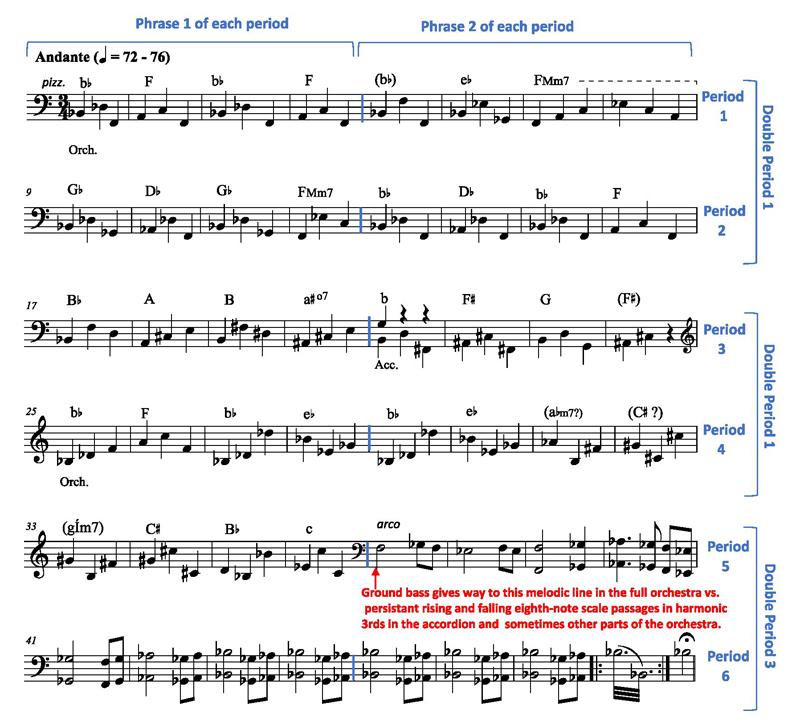
| Extracted bass line of section 1 of the Passacaglia movement with offered phrase markings and implied harmonic qualities. |
This section comes to a clear conclusion only to seemingly begin again after a brief pause. It is initially identical to the first period of the previous section but now a half step lower in A-minor and gives the impression momentarily that the movement is starting all over again. It soon goes its separate way, however, though remaining closely similar in design to that of the first section. See Example 2 to observe the similarities and differences between the two sections.
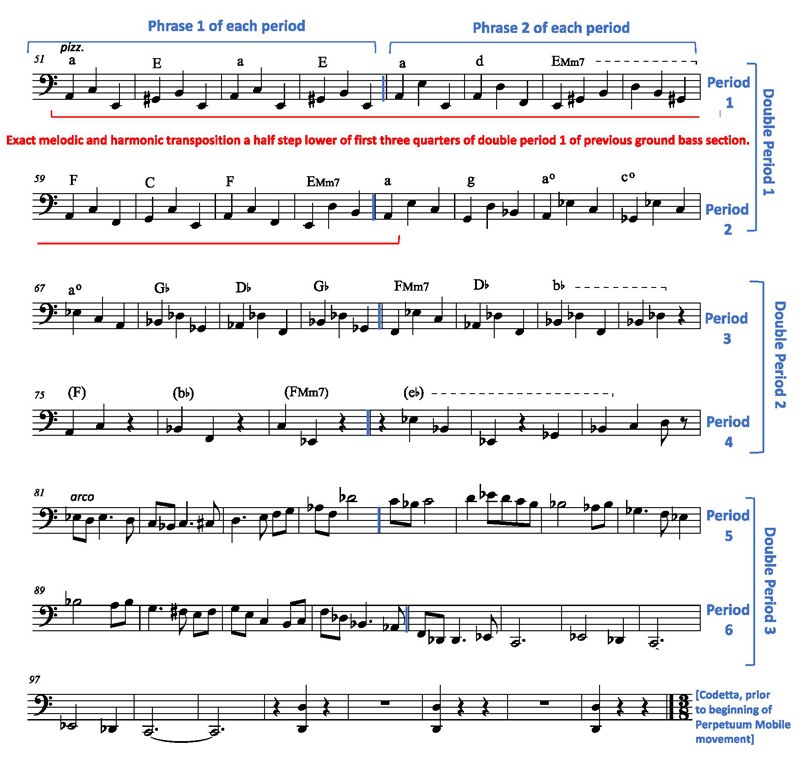
| Example 2. Extracted bass line of section 2 of the Passacaglia movement with offered phrase markings and implied harmonic qualities. |
Against these deliberately exposed and emphasized bass lines, which vary far too much in pitch and harmony to constitute a true repetitive passacaglia ground bass, is a haunting counter melody with a Latin flavor and suave rhythm that the accordion either shares or alternates with the upper strings at different times. Occasional sparse and very tasteful touches of color supplied by the brass and percussion instruments beautifully enhance the effect of the theme at just the right moments. As a final touch, modest tension between the bass and the main melodic lines of the soloist as well as the orchestral instruments is created by freely permitted moments of incidental dissonance that are often the result of the effect of added harmonic thirds to the more-or-less plain triads encountered in the “ground bass” lines, examined in Examples 1 and 2 above, independently of the counter melodies of the upper strings and accordion part. The effect is quite sensual, often sweetened by consecutive harmonic thirds in the accordion, but also somewhat foreboding due largely to the rhythmically persistent and somber quarter-note march of the faux ground bass. These main upper melodic motifs may be viewed in Example 3, where they are labeled as “counter melody a” and “counter melody b.”
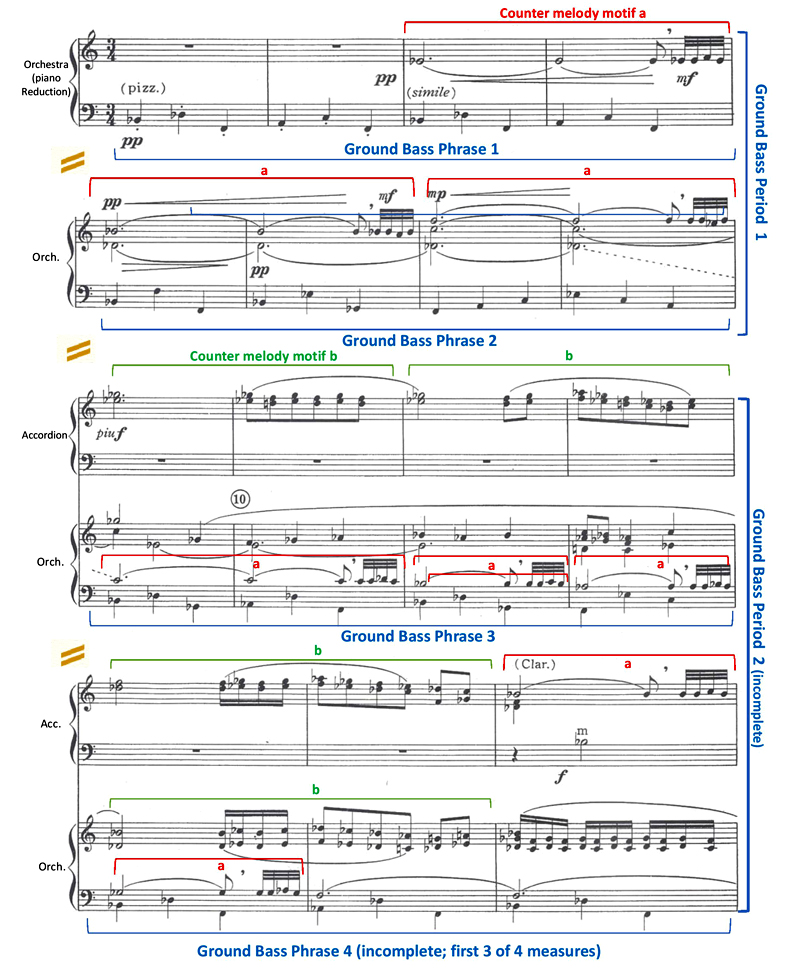
| Example 3. Beginning measures of the Passacaglia ground bass with the upper parts now shown and revealing more complex harmonies and suave melodic motifs and lines. |
After approximately five minutes and 104 measures, the rather melancholy Passacaglia movement comes to a peaceful end on a nonetheless pensive sounding G minor triad, and the livelier Perpetuum Mobile follows without pause. The 3/4 time signature of the Passacaglia is cleverly converted into 3/8 for the Perpetuum Mobile, with the quarter note beat of the first time signature equaling the dotted quarter value (equaling in turn the three eighth notes’ worth in each measure) of the entire measure of the new, thus increasing the tempo significantly by that means alone. In other words, all three beats in the new 3/8 meter equal what was only one beat in the preceding 3/4 one.
The title or description of “perpetual motion” in its various languages is often applied to rapid virtuosic musical tour de forces allowing few if any moments for pause in their unbroken, breathless melodic flights. Famous examples include Rimsky-Korsakov’s popular Flight of the Bumble Bee, Paganini’s Moto Perpetuo, Op. 11, and so-called “patter arias” in opera, such as “I Am the Very Model of a Modern Major-General,” from Gilbert and Sullivan’s The Pirates of Penzance. These characteristics certainly apply to the accordion part of Serebrier’s Perpetuum Mobile movement, as will be explained below.
The movement begins with a six-measure orchestral introduction of dotted quarter note octaves in shimmering tremolo that form an arpeggio of a B-flat minor tonic triad (B-flat, D-flat, and F) across the first three measures and an F-major dominant triad (in the order of A, C, F) over the next three, thus preserving the B-flat tonal centering of the previous Passacaglia movement and the initial six notes of its ground bass. This six-note, six-measure figure then becomes a staccato bass line in the main body of the movement that is repeated in succession seventeen times in the accordion’s left-hand part and lower pizzicato strings while also serving as an accompaniment to the main melody in the right hand. The latter is made up exclusively of unending sixteenth notes which persist without a break (thus creating “perpetual motion”) for 116 of the 218 measures comprising the entire movement (counting the repetitions of four sections therein).
Given that the new ground bass is a mere fraction of the original from the first movement, its label might be more properly “demoted” to that of a mere “basso ostinato” since most passacaglias tend to possess longer, more melodic, and often periodic two-phrase ground basses. Nonetheless, due to its strictly repetitive and unrelenting bass line, the Perpetuum Mobile is more of a true passacaglia than is the so named first movement. See Example 4.

| Example 4. Beginning of the Perpetuum Mobile movement. The first three occurrences of the six-note ground bass in the accordion’s left-hand manual and lower strings are bracketed and, beginning with measure 7, accompany the main moto perpetuo melody of unbroken sixteenth runs in the accordion’s right-hand manual. |
Eventually, this gradually predictable activity fragments into new melodic motives that are more chordal in nature along with dissonant trills and wild descending glissandi. Occasional rhythmic “bumps in the road” where the measures momentarily shift in and out of surprise metrical changes of 4/16, 3/16, and 1/4 add drama and a further suggestion of Latin rhythms with their characteristically offbeat accents. A prolonged final flight from this point finally careens to a sudden end, marked by a fatal downward right-hand glissando in the accordion to a low unison A with the orchestra. See Example 5 for examples of all the above.
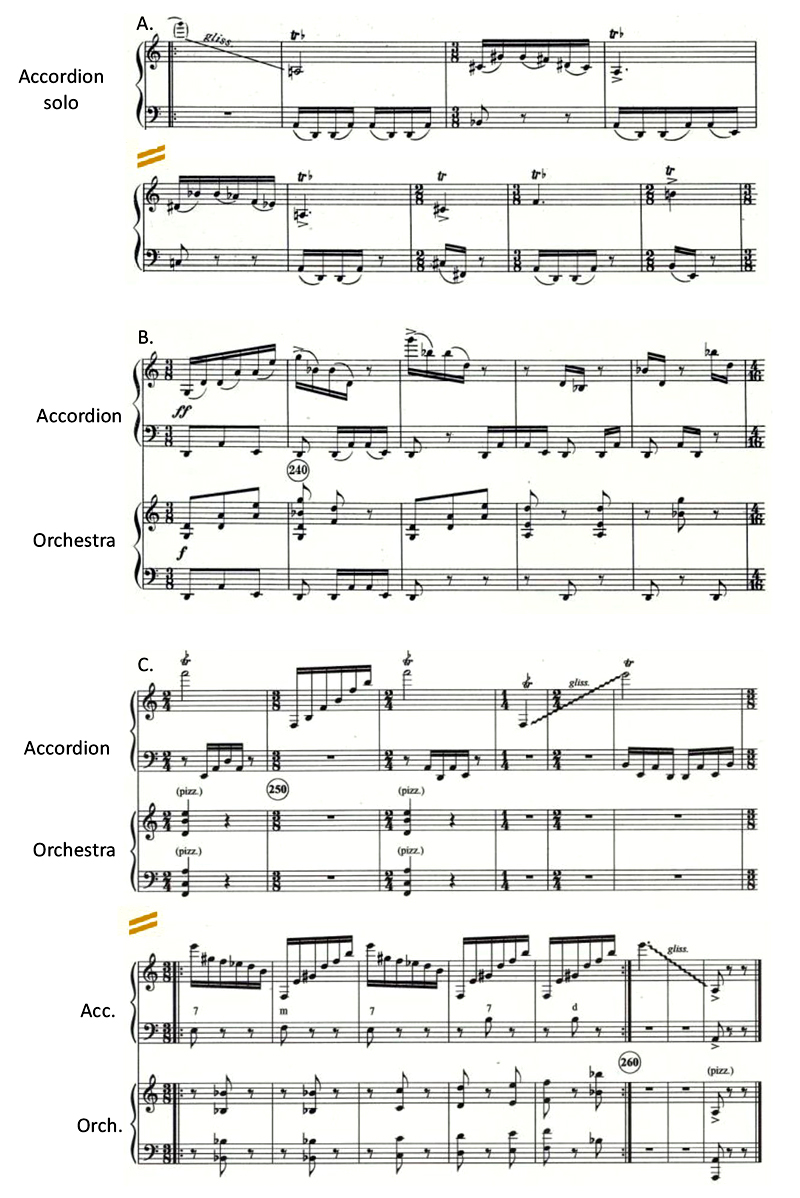
| Example 5. Samples of later departures from the steady 16th-note moto perpetuo runs that open and permeate most of the Perpetuum Mobile movement: A. Measures 205-209; B. Measures 239-243; C. Ending measures of the movement including repeating coda, measures 249-262. |
A practical disadvantage of music for large ensembles such as this is the high expense of production. This is further complicated by the reluctance of established musical organizations to include contemporary works on their programs due to their patrons’ unfortunate difficulty understanding and accepting new musical directions and innovations. Perhaps for these reasons, at least in part, Serebrier indicated in his score that the Perpetuum Mobile could be successfully performed either as a solo or a duet with the piano reduction part provided in the published score (which the writer had the pleasure of doing once with William Schimmel playing the piano accompaniment at one of the AAA Master Class and Concert Series programs at the Tenri Institute, in New York).
Regarding the solo option, the left-hand part doubles the rather sparse orchestral accompaniment to such a degree in this movement that the absence of the orchestra would be acceptable. However, the accordion part in the first movement is too intertwined with and dependent upon the thematic and rhythmic elements of the orchestra to stand alone, although it, too, could be appealingly performed if accompanied by the orchestral piano reduction.
Similarly, the final movement of Paul Creston’s concerto for accordion and orchestra stands alone as an excellent solo and has often been presented in that form by this writer and others; but the first and second movements are not as satisfying in this way for the same reasons stated above for Serebrier’s Passacaglia. Nevertheless, the entire concerto has been performed quite effectively by the writer and others a number of times with the published score’s piano reduction of the orchestral part played by an accompanist.
Another example of the solo option sanctioned by Creston is his Fantasy for accordion and orchestra. In fact, it is performed as a solo far more often than with piano or orchestra. In 2014 it experienced yet another transformation when Mary Tokarski performed it with the AAA Festival Accordion Orchestra, conducted by Joan Sommers, at the 75th AAA Anniversary Festival in New York City. Recordings of this as well as the solo rendering, performed by Carmen Carrozza, may be heard on the CCC homepage listing of AAA commissioned works.
Of course, the originally intended form of all these works is always preferable to the solo and piano-accompanied renderings, but the latter are better than nothing, and certainly more affordable. One need look no further than Johann Sebastian Bach’s keyboard transcriptions of concerti by Telemann and Vivaldi or Franz Liszt’s celebrated piano arrangements of the Beethoven symphonies to see that such partial or complete transcriptions in performance are not a new idea.
Whether the Passacaglia and Perpetuum Mobile is played with orchestra or piano, or partially as a solo, it deserves many revivals. Furthermore, its second movement would certainly serve very well as a solo test piece in future AAA and other competitions. Hear the original version on the CCC homepage.
Notes:
* Since the writing of the 2015 article, however, another earlier letter from Serebrier to Bennett expressing the wish to be commissioned by the AAA was discovered in the Bennett archive. It is dated May 11, 1962, and was mailed from the Utica College of Syracuse University, in Utica, New York, where the impressive twenty-three-year-old was serving as conductor of the Utica Symphony. Enclosed with the letter was a “brief curriculum vita” of five pages listing startling accomplishments in his brief career up to that point. He also offered to send copies of his compositions published by Southern Music for Bennett’s perusal. Bennett courteously replied that funds and time were not available at the moment for a new commission, but that she would contact him “as soon as an opening for another new composer presents itself.” That action and the commission did eventually take place shortly following Serebrier’s second letter to Bennett in 1969 after he moved to New York to serve as assistant conductor to Leopold Stokowski and the American Symphony, as reported in the 2015 article.
** (http://www.nromusic.com/about-the-nro/our-history/)
*** http://www.amherstsymphony.com/index.php?option=com_content&view=article&id=88:albert-schlisserman-md&catid=9:brass-section
**** ”Serebrier; Symphony No. 3,” Naxos, cat. no. 8.559183
The writer wishes to thank Max Lifchitz, William Schimmel, José Serebrier, Briana Francis (Lakewood branch of the Jefferson County, Colorado, Public Library system), Martin Leuthauser (Denver Public Library), and Kathleen Clabby (National Repertory Orchestra) for their invaluable assistance and sharing of information for this article.
During 2016 Dr. McMahan and Dr. William Schimmel performed the AAA commissioned work Sontag in Serejevo, by Dave Soldier, at the twenty-second annual AAA Master Class and Concert Series, Tenri Institute, New York City, July 29-31. McMahan also premiered a new composition of his at these concerts, Three Whims, for bassoon and accordion, with Devon Yasamune Toyotomi, bassoonist, as well as a new work by Toyotomi himself for the same instruments. McMahan also premiered another new work of his, Miscellany, for Theremin and accordion, during the previous year in the 2015 Tenri series, with New York Thereminist/flutist/composer Elizabeth Brown.
The AAA Composers’ Commissioning Committee welcomes donations from all those who love the classical accordion and wish to see its modern original concert repertoire continue to grow. The American Accordionists’ Association is a 501(c)(3) corporation. All contributions are tax deductible to the extent of the law. They can easily be made by visiting the AAA Store at http://www.ameraccord.com/cart.aspx which allows you to both make your donation and receive your tax deductible receipt on the spot.
For additional information, please contact Dr. McMahan at grillmyr@gmail.com
Upcoming Events2024 AAA 86th Festival,
July 12-14, 2024 West
Conshohocken, PA in the Philadelphia Area Carrozza Scholarship Fundraiser, September 15, 2024 Famee Furlane Club, NY. 2024 Elsie M. Bennett Accordion Composition Competition. Information and entry: Entry closing date, May 12, 2024. 2023 AAA 85th Anniversary Festival Daily ReportsJuly 12-16, 2023
2023 AAA Color Journal (47 pages) AAA History ArticlesHistorical Articles about the AAA by AAA Historian Joan Grauman Morse Music CommissionsOriginal works commissioned by the AAA since 1957
Recent articles: Download Composer's Guide to the Piano Accordion
AAA NewslettersLatest newsletters are now online. |